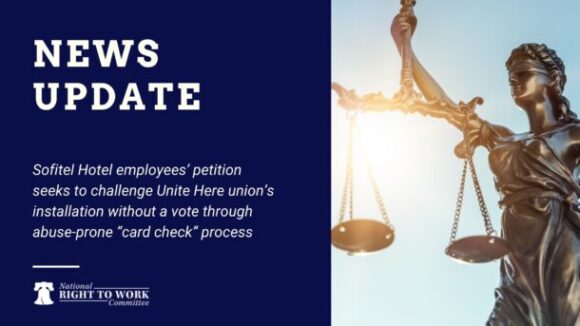Foundation Fires Back Against Biden NLRB ‘Card Check’ Mandate
Brief challenges Labor Board’s attempt to expand coercive, anti-employee organizing scheme
Subscribe to The National Right to Work Committee® Website Updates by Email
As his second term as Indiana governor winds down, Mitch Daniels could have ridden into Iowa, New Hampshire, and South Carolina the governor to the 23rd Right to Work State. However, in a National Review Op-Ed, National Right to Work President Mark Mix explains how Daniels folded his legislative hand while holding a full house:
On today’s Uncommon Knowledge episode, Gov. Mitch Daniels flipped a question about his opposition to a state right-to-work law by saying that a “better question is what the right-to-work people think they were doing.”
I’m glad he asked, because we are confident Governor Daniels knows exactly what we were doing. And as the saying goes, everyone is entitled to his own opinion, but not his own facts.
Daniels asserts that the idea of a right-to-work law came “out of nowhere,” yet since 2003, Indiana citizens determined to free themselves from the shackles of compulsory unionism have been working tirelessly to pass right-to-work protections for Indiana’s workers. Led by the nearly 120,000-member Indiana Right to Work Committee, pro-right-to-work Hoosiers sent many thousands of postcards, letters, and e-mails to their legislative candidates urging them to support right-to-work.
In 2010 alone, Indiana Right to Work mailed a series of letters to more than 200,000 Hoosiers in targeted districts reporting where their candidates for state house and state senate stood on the right-to-work issue.
Meanwhile, dozens of winning candidates (including Ron Bacon, Sue Ellspermann, Rebecca Kubacki, Kevin Mahan, Jud McMillin, and Tim Wesco) repeatedly sent out direct mailings to voters announcing right-to-work as a key plank in their platforms, while still others trumpeted their support in town halls and other public forums. (All of which was laid out in a letter to Daniels from the head of Indiana Right to Work dated January 6.)
Public-opinion polls consistently show that nearly 80 percent of Indiana voters oppose forced unionism, and members of Daniels’s own party think it is a winning issue enough to bring it up. And since 2004, there have been three votes on an Indiana right-to-work bill in the state house — making right-to-work hardly an issue that has come “out of nowhere.”
Additionally, Daniels has claimed that the rest of his agenda would have been derailed if right-to-work came up. As such, Daniels has urged the delay of the introduction of right-to-work since December, essentially cuing the Democrats to block the bill from the start by pushing the introduction of the bill to the point where the Democrats could defeat it by leaving the state for just a day or two. And in the end, Daniels’s other legislative priorities were blocked anyway, despite his preemptive surrender on the right-to-work issue.
If Daniels had just shown leadership and decided to fight this battle early in the legislative session (as advised), workplace-freedom advocates would have won the battle, as majorities of both houses are on the record in support of a right-to-work law. Instead, hundreds of thousands of Indiana’s workers will continue to be forced to pay union dues and fees as a condition of employment, while (as Daniels admits) one in four businesses looking to relocate will not even consider his state.
Daniels’s efforts to block right-to-work stand in stark contrast to the positive strides made by Governors Scott Walker (Wisconsin), Chris Christie (New Jersey), John Kasich (Ohio), and Paul LePage (Maine) in taking on forced unionism.
Governor Daniels’s failure of leadership (and truthfulness) on this issue should give serious pause to those who think he’s ready for national office.
— Mark Mix is president of the National Right to Work Committee.
Brief challenges Labor Board’s attempt to expand coercive, anti-employee organizing scheme

Josh Hawley distances himself from pro-Right to Work pledges, aligning with union bosses like the Teamsters, despite their history of corruption.

Sofitel Hotel employees’ petition seeks to challenge Unite Here union’s installation without a vote through abuse-prone “card check” process